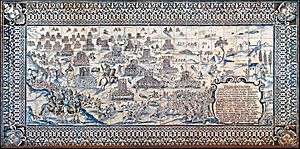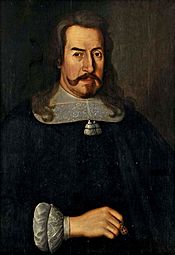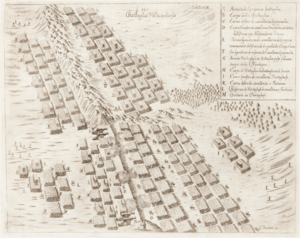Battle of Montes Claros facts for kids
Quick facts for kids Battle of Montes Claros |
|||||||
|---|---|---|---|---|---|---|---|
| Part of the War of the Portuguese Restoration | |||||||
 Battle of Montes Claros, Palace of Fronteira |
|||||||
|
|||||||
| Belligerents | |||||||
| Commanders and leaders | |||||||
| Strength | |||||||
| 22,000 | 22,600 | ||||||
| Casualties and losses | |||||||
| 2,700 killed and wounded | 8,000 killed and wounded 6,000 captured |
||||||
The Battle of Montes Claros was a very important fight. It happened on June 17, 1665, near a town called Borba in Portugal. This battle was between the armies of Spain and a combined force from Portugal and England. It was the last big battle in the Portuguese Restoration War. Portugal won a huge victory. Many people see it as one of the most important battles in Portugal's history.
Contents
What Led to the Battle?
By 1665, the war to restore Portugal's independence had been going on for 25 years. Even though Spain had faced many problems, King Philip IV of Spain really wanted to stop Portugal from being independent. After a tough battle in 1662, Spain decided they needed to end the war quickly. They thought they could win by capturing a major Portuguese city or by completely destroying the Portuguese army.
Luis de Benavides Carrillo, Marquis of Caracena was chosen to lead Spain's new invasion. He was a skilled commander. Carrillo planned to capture Lisbon, the capital of Portugal. To do this, he first wanted to take Vila Viçosa and then Setúbal.
Spanish Plans and Problems
Carrillo wanted to gather a very large army. He hoped to have more soldiers than the Portuguese. But King Philip IV of Spain was getting very sick. The Spanish court worried that if the king died, other countries might help Portugal even more. So, they told Carrillo to invade quickly. Spain also had money problems. They feared they might not be able to pay their army if the war lasted much longer.
Portuguese Preparations
The Portuguese were ready for an attack. They moved 3,500 soldiers from the north to the south. Another 7,800 men came from Lisbon. These troops were led by António Luís de Meneses. He had beaten the Spanish in a battle six years earlier. They also had help from about 2,000 experienced English soldiers. These English troops were led by the Duke of Schomberg.
Meneses had defended the border with Spain for over 20 years. He knew Carrillo had many ways to invade. So, he made the border defenses stronger at Elvas and Campo Maior. He hoped this would make Carrillo choose a specific route. Meneses knew Spain had trouble supplying their army when they invaded. He planned to keep Carrillo's army stuck in the border areas. This would wear down their numbers. The Portuguese also knew the Spanish king was ill. Meneses thought this would force Spain to attack soon.
The Invasion Begins
Carrillo's army entered Portugal on May 25. He easily took Borba because the Portuguese soldiers had left it. Then, he started to attack Vila Viçosa. He captured the city but could not take its strong castle. He had to lay siege to the castle.
The Portuguese decided to give up some land to gain time. They hoped the rough land would weaken Carrillo's army. But Meneses still wanted to fight the Spanish army on a battlefield he chose. The main Portuguese army moved towards the Spanish forces around Vila Viçosa. But they stopped at Montes Claros. This place was halfway between Vila Viçosa and Estremoz.
Carrillo was losing many men during the siege of Vila Viçosa. By June, Portuguese groups were attacking his supply lines. Vila Viçosa's castle was also fighting back harder than expected. The Spanish court demanded action. Even with these problems, Carrillo still wanted to capture Lisbon. But when he heard that Meneses's smaller army was coming, Carrillo decided to fight them.
The Battle
Meneses set up his army in a strong defensive position. They were next to a long ridge on its southern side. A thick forest and hills were further south of the Portuguese. By defending the space between these two natural features, Meneses planned to limit how many soldiers could fight at once. This would help against the larger Spanish army.
He placed his strongest infantry, including experienced soldiers and foreign fighters, in two lines in this gap. These troops were led by Frederic Schomberg. Meneses also put his cannons there to support them. The rest of the Portuguese army was kept in a third line as a backup. They were ordered to stop the Spanish from climbing the ridge. Carrillo knew about these defenses. He gathered his cavalry (soldiers on horseback) and cannons for a big attack on the gap.
The battle started with Spanish cannons firing at the Portuguese lines. This created gaps in the first line of soldiers. Then, the Spanish cavalry charged the Portuguese left side. They managed to break through some units. The Portuguese soldiers formed squares to defend against the cavalry. But this made them easy targets for the Spanish cannons.
The Duke of Schomberg's men gathered around some buildings on the Portuguese left side. They used these buildings and a vineyard wall to break up the large group of Spanish cavalry. The Portuguese cannons fired again and again into the Spanish cavalry, causing many deaths. When the first Spanish charge pulled back, Meneses moved his first line back. He combined it with the second line. A Spanish cannonball killed Sir Francisco da Silva Moura, who led part of the second line. Meneses then took command himself.
A second Spanish cavalry attack and cannon fire again caused many deaths among the Portuguese soldiers. But the Portuguese cannons forced the Spanish to retreat.
Carrillo then ordered a huge third attack. This time, both cavalry and infantry charged the Portuguese defenses. The fighting was very intense. The Duke of Schomberg's horse was shot, and he almost got captured by the Spanish. The Portuguese cannons were especially deadly. They fired shot after shot into the advancing Spanish soldiers. The Spanish cannons soon had to stop firing. They were afraid of hitting their own men. The Spanish attack failed. Spanish soldiers and cavalry were packed together, becoming easy targets for the Portuguese. The Spanish cavalry alone lost over 1,200 men in this third charge.
The Portuguese forces were mostly still strong. But the Spanish army, which had already lost many soldiers, started to lose hope. They had put all their hopes on the cavalry charges. Since they could not break Meneses's defenses, Carrillo slowly began to pull back to the north.
After seven hours of fierce fighting, the Portuguese launched a counterattack. The Portuguese cavalry, led by D. Luis Melo e Castro, had not played a big role until now. They charged and broke through the weakened left side of the Spanish army. The Spanish army began to fall apart. They fled in a rush towards Juromenha. They left behind all their cannons and many dead and wounded soldiers. Thousands of Spanish soldiers were captured, including eight Spanish generals.
Almost all of the 1,500 Spanish soldiers who hid in the woods around Vila Viçosa died later. They died from their wounds and hunger in the weeks after the battle. The Portuguese captured many weapons and supplies. In this campaign, Spain lost about 4,000 killed on the battlefield. Another 1,200 to 1,500 died during the siege of Vila Viçosa before the battle. Almost 1,500 who ran away died in the weeks after. Also, 6,000 were captured and 4,000 were wounded. The Portuguese lost about 700 killed and over 2,000 wounded.
What Happened After?
The Battle of Montes Claros pretty much ended the major fighting in the Portuguese Restoration War. It made sure Portugal was truly independent from Spain. Spain did not try another invasion. Instead, this defeat led to a treaty being signed between England and Spain in Madrid in 1667. Because of this, England helped Portugal and Spain sign the Treaty of Lisbon a year later. Portugal's new ruling family, the House of Braganza, was officially recognized.
See also
 In Spanish: Batalla de Villaviciosa (1665) para niños
In Spanish: Batalla de Villaviciosa (1665) para niños



